All these engineering specs are just dandy, but they come alive in a way that would shock you. Now, Subaru knows just how significant the improvements are, which is why they were so insistent we drive the 2015 WRX STI back to back with the 2014 on the track. That experience drove home all the wild claims Subaru has been making recently (such as: the steering on the WRX is better than the BRZ). We had no idea how right they were.
After spending the morning driving to the track in the WRX (to be covered fully in its own review), the STIs were lined up and ready to go as soon as we finished our trackside lunch. The seats were immediately accommodating, with taller backrests, separate, adjustable head restraints (safer and more comfortable) and greater adjustability, but even more aggressive bolstering without being too narrow to put the squeeze on a 200-pounder like myself. The new steering wheel is thicker, of smaller diameter with a flat bottom, but the same familiar steering wheel controls.
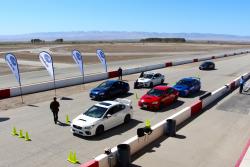 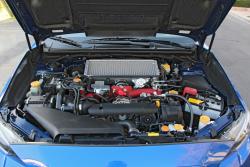 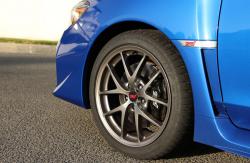 2015 Subaru WRX STI. Click image to enlarge |
Firing up with the push-button start brings the familiar turbocharged, intercooled 2.5L flat-four to life, the unique rumble from its uneven headers now fortified by a special “sound creator” that directs some portion of the air intake through a damper and into the cabin to accentuate this signature Boxer’s unique pulsating voice at high revs. So yeah, it sounds even more like a growly STI Boxer.
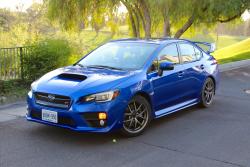 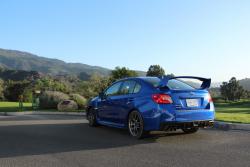 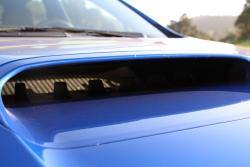 2015 Subaru WRX STI. Click image to enlarge |
Its peak 305 hp remains unchanged, arriving at 5,600 rpm, and the 290 lb-ft of torque arrive slightly earlier at 4,000 rpm and stays mostly on tap until falling off at 6,000 rpm. Subaru claims the peak power arrives earlier and stays longer, but more extensive track testing would be in order to confirm these subtle changes (hint, hint), but there is no doubt the throttle response is quicker thanks to changes in the ECU mapping.
There is no question 305 hp is just plenty for the STI’s 1,527–1,564 kg, and the 5 kg/hp power-to-weight ratio puts it ahead of it nemesis, the Mitsubishi Evo (about 5.5). With that kind of power and throttle response, the STI shoots out of corners with menace and sends dirt clouds choking up the hazy sky if you happen to launch from a gravel shoulder. Or at least so I’m told. Power is as good as it’s ever been and entirely satisfying in the mid-to-high rpm range.
Doesn’t hurt that the STI has one of the most effective all-wheel-drive systems on the market, carrying over the multi-mode DCCD (driver-controlled centre differential) system that can automatically vary torque between front and rear axles with a bias to the front or rear, or be adjusted to specific splits between front and rear, from 50:50 to 41:59. STI also retains mechanical limited slip differentials on both axles, of the helical type in front and TorSen at the rear. It’s a bit old-school, but it is unquestionably brilliant, and the power flows to the wheels in a seamless waves as you rotate, slip and slide in, through and out of corners.
One advance Subaru has made with their signature Symmetrical AWD system is torque vectoring, including both inside front wheel braking via the vehicle’s VDC (Vehicle Dynamic Control, Subaru’s term for traction and stability control) and active torque distribution to the outside front wheel. For track use and big snowy parking lots, VDC can be disabled while retaining the active torque vectoring.
The only transmission for the STI remains the six-speed manual transmission, breathed on just enough for Subaru reps to have something to talk about. It retains its ratios and mechanical linkage, but apparently has enhanced detents for better feel and smoother shifting. I think I’m coming around on the STI shifter, because I did enjoy the shifter and clutch feel, but I was not happy with the brake and gas pedal setup – it’s set up for a different style of heel-toe downshifting than I have learned, so that made me grumpy that I had great difficulty blipping the throttle on downshift corners.
But I couldn’t stay grumpy for long, not with this amazing sport compact a willing weapon at my hands. My last foray in a 2014 STI convinced me of its tenacious grip and left an indelible impression on a few lucky passengers around a lonely clear onramp, but our back-to-back drives showed us just how much was left to exploit from this engine.
About time we talked about the actual handling, anyway, isn’t it?














